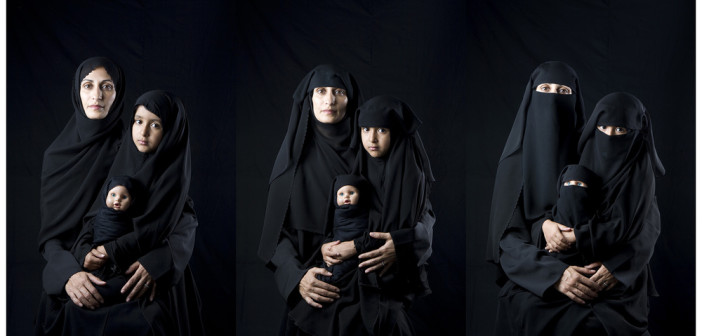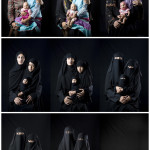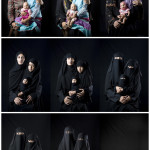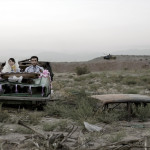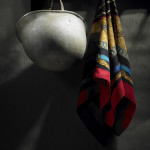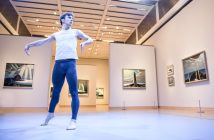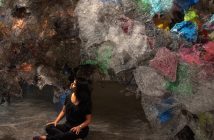It comes as no surprise that a photograph’s value is about access. While some art has the luxury of being unique as an object, a photograph is only as unique as what it represents. It’s a window into a moment or expression to which the audience has limited access. It’s the sneaky stuff: the behind-the-scenes, the front lines, the temporal, and the lives of others.
In She Who Tells a Story, currently on view through January 12 at the Museum of Fine Arts, Boston, curator Kristen Gresh has selected established international photographers as well as a few stars on the rise. The title of the show is a translation of the Arabic word "rawiya," which is also the name of a collective of female photographers in the Middle East co-founded by Tanya Habjouqa and Newsha Tavakolian.
Though their backgrounds are diverse, the women included in She Who Tells a Story find commonality in their desire to manipulate the demarcation of public and private space. From the gaze of others, to family life, performance or the veil, these photographs are indicative of women striving to reconcile autonomy with obligation to forces within their culture or from without.
Most of the storytelling in the exhibition is crafted from the outset or manipulated after an event, making reference to traditional formats in order to shape the context of the narrative before plot twists. Traditional portraiture formats dominate, but old postcards, Japanese screens, album covers, and cartes de visite are present. Within these structures, layers of misdirection surface; beauty is a vehicle in which to delay the delivery of a message.
Eyes dominate many of the compositions, fixed in a stare intended to discomfort the viewer.The repetition in Boushra Almutawakel's Mother, Daughter and Doll series and Jananne Al-Ani’s Untitled I & II discuss the power and privacy of the veil using themselves and members of their family as subjects. The singers of Newsha Tavakolian’s Listen series enact the fantasy of being on stage although in Iran females are banned from performing solo in public. With their eyes closed in the passion of their performance, the performers make peeping toms of the audience.
The presence of calligraphy in some of the most figurative pieces presents a subtle reminder of the lingering aesthetic legacy of aniconism, while also conveying the metaphor of text as the subject’s silent voice. For a Western audience, most likely illiterate in Farsi and Arabic, this makes many pieces more opaque, underscoring the barrier between Western eyes and the personhood of the portrayed. However, to come away with the conception of these photographs as simply about East and West would be incorrect. Even if most Americans could read the poetry inscribed on the skin of the subjects of Neshat’s Book of Kings, they might still be unfamiliar with its references to Ferdowsi’s epic poem, Shahnahme, or its place in Persian culture. Certainly to make the connection, as Neshat does with the events of the Arab Spring and the Iranian Green movement, requires fluency outside of language alone.
Other artists tell us the story of the individual in the arena of modern life, as well as hope for the future. Rania Mattar’s portraits of adolescent girls surrounded by a tableau of their belongings invites the viewer to parse the frame for clues, as though the identity of the women they will become is scattered around the room like tea leaves.
The young couple presented in Gohar Dashti’s Today’s Life and War persists in their everyday activities while surrounded by abandoned tanks and artillery that still contain the threat of violence. Dashti’s use of color and organic shapes contrasts against the army drab in a landscape strewn with the evidence of past military action.
The role of men in She Who Tells a Story is one of conspicuous absence, or as players against a backdrop of violence and conflict. As noncombatants, the vacuum of tumult and revolution isolates women from the experience of the men in their lives. In Shadi Ghadrian’s new series, a single artifact of war disrupts the placid almost commercial sheen still life of domestic objects. Devoid of human figures, Nil, Nil reminds us that there are no winners on or off the field of battle.
While many of the artists here raise the curtain on a theatre of public consumption in on which private life is staged, often using other women’s stories, Rula Halawani’s large, unreversed negatives are an interesting example of an artist processing terrible events she has witnessed. Conceptualized as a critique of journalism’s ability to convey human suffering, her treatment keeps her, as well as the audience, from reliving the event as she experienced it.
Another kind of story runs parallel to the art here: the one of curatorial choices. Although the curatorial comments attempt to shape the narrative of the show with subheadings such as "Deconstructing Orientalism," "Constructing Identities," and "New Documentary," the women shown are mature voices and capable of telling their story through their craft.
It is telling that during the period much work from She Who Tells a Story originates, women in the United States were asking whether employers have a right to deny female employees birth control coverage, and whether, as the Guerrilla Girls famously implored, "...women have to be naked to get into the [Metropolitan Museum of Art]?"
While the exhibition exploits exoticism, the allure really hinges on the relative novelty of female artists in a major US museum. In She Who Tells a Story, the real perspective we gain access to is that of "she."
- Shirin Neshat, Speechless
- Boushra Almutawakel, from the Mother, Daughter, Doll series. 2011.
- Gohar Dashti, Untitled #5. 2008.
- Rula Halawani, Untitled XIII. 2002.
- Shadi Ghadirian, Nil, Nil #4. 2008.

